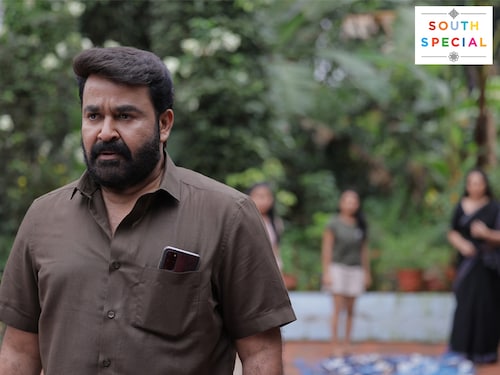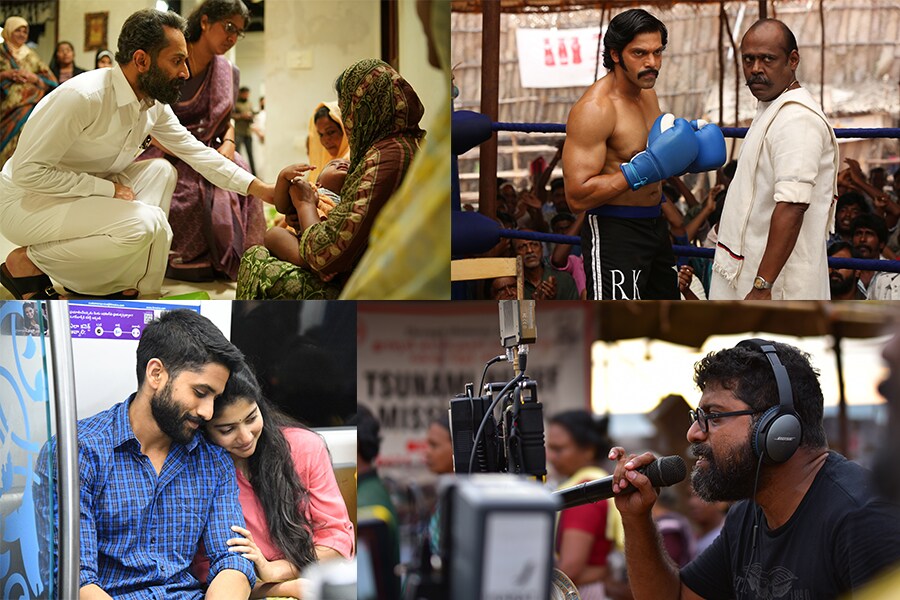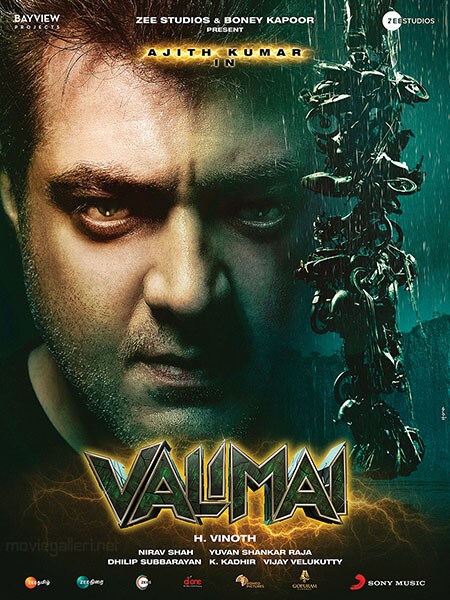OTT Revolution: A boon for filmmakers
Streaming platforms offer a diverse range of storytelling options to directors in the South, newfound stardom to lesser-known actors and spoil the audience for choice as they consume content in differ



The pandemic has changed the concept of filmmaking and the way a movie is sold in South India. OTTs have become a way of life for producers of Tamil and Malayalam films, while Telugu and Kannada movies are still rooted in the theatrical business. When theatres were shut for a long period in Tamil Nadu and Kerala (still shut) during the pandemic, mainstream cinema moved over to OTT platforms. Superstars like Suriya in Tamil and Mohanlal in Malayalam cinema tasted huge success when they premiered their respective films Soorarai Pottru (2020) and Drishyam 2 (2021) on OTTs. And Fahadh Faasil became an OTT superstar with films like CU Soon (2021), Joji (2021), Malik (2021) and a few others.
Suddenly, in commercial cinema, stories were budgeted and written keeping in mind the new wave of OTT audiences.Renowned filmmaker and producer Mani Ratnam, who has made exclusive content like the anthology Navarasa for Netflix, says: “It’s the future and growing. There are a lot of ideas that do not fit into a format as a feature film. OTT opens up different ways of storytelling, big and small. At the same time, I feel both OTTs and the theatrical experience will coexist."
Leading Malayalam producer Anto Joseph says: “OTTs have given filmmakers as well as their audiences a more diverse range of viewing options. Their reach is phenomenal and they have also brought in much-needed other language viewers who seem to be enjoying Malayalam content due to quality sub-titling." Karthick Naren, a young, short-filmmaker-turned-director in Tamil adds: “OTTs are definitely attracting younger audiences as they can relate to the content. I did one of the episodes in Navarasa for Netflix. The kind of response my Project Agni in the web series got was overwhelming and highly satisfying."
The most important factor is that OTTs do not have to follow a “normal commercial theatrical format", and can be different, which has created newfound audiences. A commercial hero like Arya delivered his biggest success as an actor and a star with the Pa Ranjith-directed Sarpatta Parambarai, which premiered on Amazon Prime Video to rave reviews. It is said to be the most-watched Tamil film so far on OTT platforms. OTTs have also created their own stars—gauged by their performances and the roles they do—like Faasil, who has not had that kind of success in theatricals. In the last one year, he had four OTT premieres, which gave him a phenomenal reach. Actor Uday Mahesh, who was unknown before The Family Man 2’s ‘Chellam sir’, is a rage today and is flooded with offers. Another reason why OTTs became a craze in the South is because of the connectivity factor—internet penetration and smartphone proliferation in tier 2 and 3 towns.
Malayalam films had the maximum straight premieres in South India on OTT platforms.
Films like CU Soon, The Great Indian Kitchen, Irul, Joji, Malik, Cold Case, Home, Kaanekkaane and many others had a direct OTT release. It is the hottest market for OTT direct premieres as theatres have been closed for the last six months due to Covid.
Recently, Chief Minister Pinarayi Vijayan said theatres will take a longer time to reopen in the state.
In fact, Malayalam has a dozen small OTT platforms that are procuring content and releasing them, thereby proving to be a boon to those films not picked up by OTT giants.

(From top) Fahadh Faasil"s Malik and Pa Ranjith-directed Sarpatta Parambarai were also a hit on OTT platforms Naga Chaitanya and Sai Pallavi"s Love Story brought Telugu audiences back to the big screens Mahesh Narayanan, director of CU Soon, which was released on Amazon"s Prime Video
OTT platforms are snapping up Malayalam films faster than any other language films, as they have found acceptance outside of Kerala among non-Malayalees. This has created a boom in production as more big-budget films earmarked for theatres are going the OTT way. Tovino Thomas’s eagerly-awaited superhero film Minnal Murali has recently been snapped up by Netflix. Mahesh Narayanan, the director who started the trend with CU Soon, says: “A churning has taken place thanks to the OTT revolution taking place as theatres are closed. Malayalam cinema is in good space where content is king. What worked is the growing number of non-Malayalee viewers worldwide. The subjects are different and rooted in local milieu, and OTTs have also brought about changes in writing and scene compositions."
The southern states traditionally have the highest theatre-going audiences in the country, and the largest number of single screens in India. Of the 9,500-odd screens in India, pre-pandemic, 50 percent are in the five southern states. Akshaye Rathi, an exhibitor with operations in Maharashtra, Madhya Pradesh and Chhattisgarh says: “Today, South Indian cinema and the strong cinema-going culture there is ahead of others due to good content, mass heroes with a huge fan base and strong marketing. Hindi cinema, except for Salman Khan and Tiger Shroff, does not produce the kind of mass movies made by South Indian superstars that reach audiences of all classes." When theatres shut down during the pandemic, a large section of the audiences—read youth—crossed over to OTTs, with their diverse content. After the first pandemic wave when theatres reopened early this year, it was Vijay’s Master, a mass entertainer, which came to their rescue. Following the second wave, theatres shut down again in April and reopened in August-end in Tamil Nadu.
But theatre collections at 50 percent capacity are yet to pick up in Tamil Nadu in Kerala, they are still closed. Theatrical collections of Telugu states (Andhra Pradesh and Telangana) have come back to somewhere near pre-Covid days, as proved by the phenomenal opening of Naga Chaitanya and Sai Pallavi’s Love Story, directed by Sekhar Kammula. The film has grossed a whopping Rs 25.4 crore only from Andhra Pradesh and Telangana.
Theatrical still remains the strongest cinema release platform in Telugu states compared to the rest of India. But Tamil Nadu, Kerala and Karnataka have not shown the same kind of liking for theatricals. In Tamil Nadu, the trade is betting big on the Diwali release—Rajinikanth’s Annaatthe—and for Pongal (January 2022) —Ajith Kumar’s Valimai—to bring back audiences to theatres. Till then, Tamil will have small- and medium-hero film releases.

Ajith Kumar"s Valimai is scheduled for a January 2022 release, during Pongal, and is expected to bring audiences back to theatres
Every year, Tamil produces around 200 films, but this year, production will fall. More and more films with either a “saleable hero" or “different content" are premiering on OTT platforms. But the catch is that the OTT biggies are only interested in the cream, and buy only 40 to 50 films a year. For the rest, the only way out is theatrical and satellite television rights.
G Dhananjayan, a producer and distributor, says: “Post the second lockdown, Kodiyil Oruvan, the film I distributed brought audiences to the theatres. Initially no OTT was willing to buy the film, but after it became a theatrical hit, the digital rights have now turned hot. However, post the second wave, the pattern of film viewing has changed as collections are good only on weekends. This is posing a challenge to the trade, but we are hoping the festival, big-star films will boost collections."

All leading actors in South India, especially Telugu stars, are backing theatrical releases. They have not moved entirely to OTT, and have a foot in theatricals. The stars know that it is their ‘box office ratings and collections’ that have made them mass heroes. South Indian stars with political ambitions cannot even think of a non-theatrical release, as fans, celebrations and box-office numbers are crucial for their longevity. In OTTs, there is no metric to measure their star power, the notion of how successful a star is cannot be gauged. The subscriptions and number of views that a particular film generates are never made public by OTT platforms. A spokesperson of a leading OTT platform says: “We are here to build a strong and good content library. Worldwide, in OTTs, there are no big stars… it is only good content that reaches across the globe. The beauty of OTTs is that anyone can come from anywhere and get recognition overnight with one show or a film."
OTT platforms are an integral part of the entertainment ecosystem and are here to stay. In the future, theatrical will have to coexist with the streamers. Now the controversy is whether the window between theatrical and OTTs should be further shrunk. Before the pandemic, the powerful multiplexes lobby had kept the window at eight weeks between theatrical and OTT releases. It came down to four weeks (28 days) when theatres reopened after the second wave, with Akshay Kumar’s Bell Bottom. But multiplexes refused to play Kangana Ranaut’s Thalaivii as the producer had brought down the window to two weeks, before it premiered on Netflix. One has to wait and watch the way the future unfolds, but overall, both theatres and OTTs will grow as the entertainment industry evolves.
The author is an entertainment industry tracker.
First Published: Oct 18, 2021, 13:36
Subscribe Now